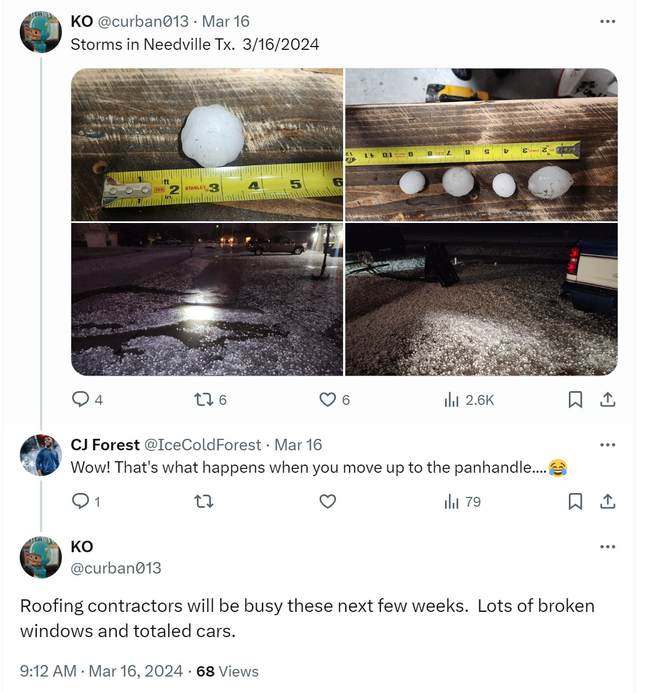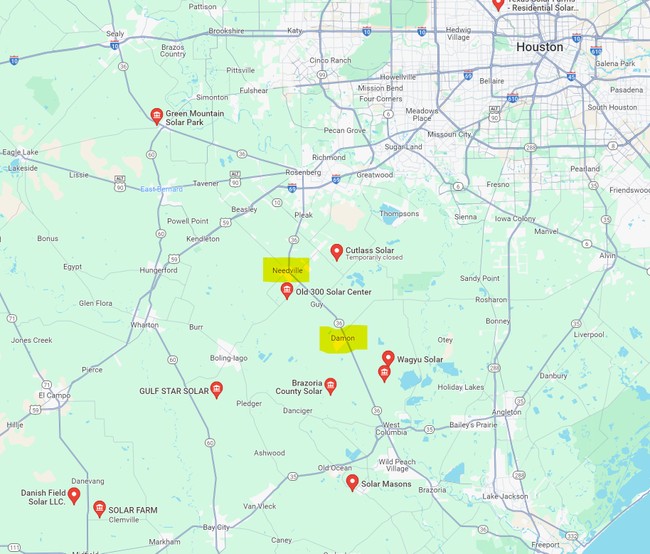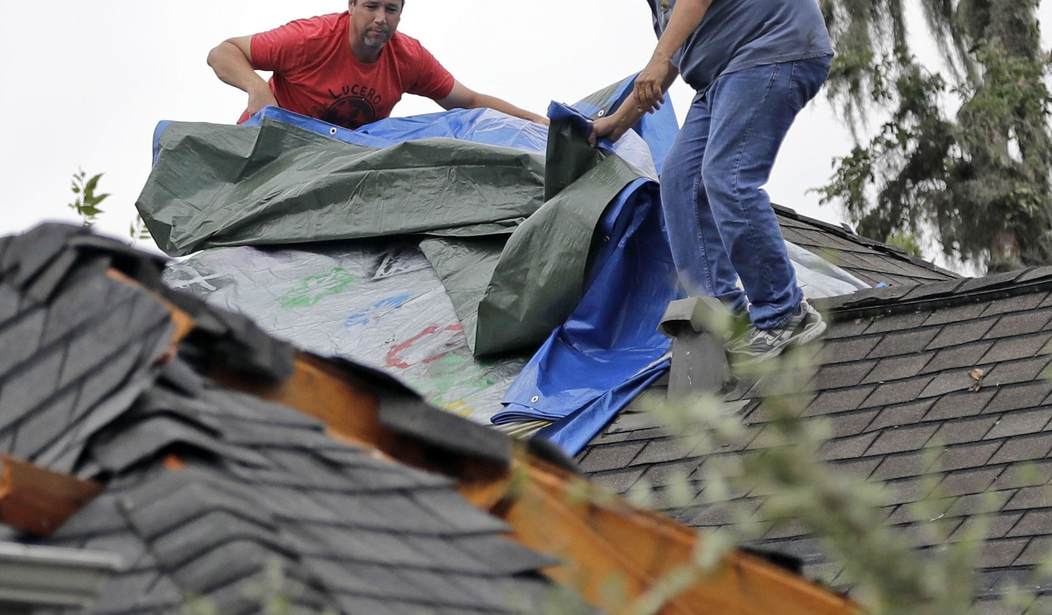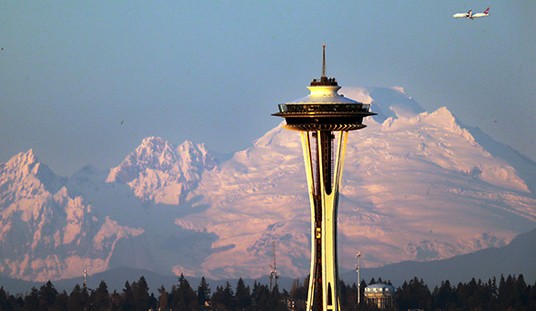An event took place in Southeast Texas between the evening of March 15 and the early morning of the 16th that is only now coming to light. As is often the calling card of early spring, some mighty thunderstorms marched their way across the country, dropping tornadoes, drenching rains, and hail of every size in their wake.
The nature of the North-South alignment of the Rockies combined with the warmer, wetter air masses laying across Texas and the Great Plains states (thanks to the Gulf of Mexico) is combustible. That enormous mountain range lets cool, dry air slip over unimpeded into the Plains, and it's that temperature differential when it runs into that Gulf moisture that is the genesis of those spectacular systems.
The phenomenon even has a name: The Texas Dry Line. You can see it in action clearly on satellite with a good explanation from NOAA.
That's why, particularly in the spring when the air coming over the range is icy cold winter blast meeting Gulf of Mexico warmth, Texas, Oklahoma, etc, have such a horrific time with monster storms. That difference in the two air masses colliding produces such tremendous instability that the storms become enormous, explosive, and horribly destructive.
Boomity. Bad things can happen. They've also been happening for millennia by virtue of topography, which is why YouTube's addition of a climate change propaganda "content bar" is so ludicrous. (Sometimes it IS just weather.)
The National Weather Service (NWS) and local media were already warning the Houston metro area of the potential for just such rockin' and rollin' on Friday morning, the 15th.
...As the threat of rainy weather that started Thursday continues into the weekend, rounds of Houston-area thunderstorms followed by a cold front on Friday could carry with them the risk of damaging winds and large hail. Let’s break down the timing so you know how to plan the day ahead.
A lucky thing, too, because by the time things cleared out Saturday morning, they'd gotten thumped by Mother Nature, but good.
The Houston area was hit by a mighty storm Friday that featured quarter-size hail and winds that whipped stronger than 60 mph.
The storm closed down rodeo rides at around 5 p.m. until the storm passed, and the rodeo was far from the only organization or area affected by the weather that stretched deep into the Texas night.
Data from the National Weather Service released Saturday morning listed numerous areas with more than 1.5 inches of rain during the past 24 hours. One area in Houston sustained 4.16 inches of rain, which is the most calculated by the weather service in the area.
In Needville, baseball-sized hail was reported around 3 a.m. Saturday morning during a major storm. Forecasters also reported a roof being blown off a house in the town.
Wind gusts topping 60 mph and supercell thunderstorms with embedded hail that size screaming down from the heavens...

...will do a ton of serious damage. They are also scary as all get out.
..."We got inundated with phone calls from residents and 911 calls," [Angleton City Manager] Whittaker said. "Power went out to virtually the north side of Angleton. We had roofs blown off buildings — (a) couple bars, couple of restaurants, couple different businesses in Angleton, signs went down."
For all the reports of roofs off in Needville and the surrounding area, some spectacular damage initially never made the news. It wasn't until a fellow who owns a helicopter business had one of his videos go viral that word got out about another farm that had taken a pounding from the hail.
No cows were injured, but wowsers - 4000 acres of solar panels looked to be pretty cracked up.
In yet another massive L for 'green' energy boondoggles, a massive swathe of solar panels in Damon, Texas were taken out by a hail storm
— Will Tanner (@Will_Tanner_1) March 26, 2024
And not only were the expensive panels rendered useless by the weather, but now they're leaking a toxic compound, cadmium telluride, into the… pic.twitter.com/vtKqRNxTN4
Yeah. If they're white, they're busted. And a majority of them are totally smoked.
Neighbors who wanted nothing to do with this farm going in are not happy in the least bit.
As the reporter says, there are "several solar farms" in that Needville/Damon area southwest of Houston.

These installations take up quite a bit of acreage, and residents who have never gotten much of a response to their concerns from the very beginning are pretty torqued about the silent treatment they're receiving in the face of this mess.
There are several solar farms in the Needville area spanning more than 10,000 acres.
Some are up and running while others are being constructed.
Nearby residents were concerned before the panels were installed.
"It was a hailstorm like we've never seen before," said Nick Kaminski who lives near the solar farms.
...Nick showed us emails he sent to Fort Bend County Commissioners, the Fort Bend Economic Development Council, and the owners of Fighting J's Solar Farm asking for the environmental impact report.
"We've asked for the same studies, and we've been treated the same way," said Mikes Fugua who also lives near the solar farms. "We got nothing out of them."
Now that the bulk of thousands of acres of panels have been smoke checked, they're fed up with not getting answers . What little they are hearing isn't helping settle anyone's nerves.
...Instead of collecting rays, panels from the Fighting Jays Solar Farm in Guy were hammered by hail. SkyDrone13 captured thousands of rows of shattered panels - damage more concerning to Kaminski than what happened to his home.
...Experts said solar panels can be made from silicon or cadmium telluride. Most home panels are made with silicon and don't contain dangerous chemicals.
Experts said that cadmium telluride panels are cheaper and tend to be found on large solar farms. ABC13 went inside the office space at Fighting Jays Solar to ask what's in the solar panels.
An employee told Eyewitness to email. ABC13 did and asked questions, including whether the compound cadmium telluride was in the equipment.
...A spokesperson called ABC13 but wouldn't answer questions on the record. The solar farm's website doesn't mention anything about chemicals in the solar panels but states that insurance policies will cover a hailstorm if it hits.
..."It's possible you dented the solar panel, but they have a lot of protection layers on top of that," Ramamoorthy Ramesh, a Rice University physics professor who has studied and worked on panels for years, said.
Ramesh said even if the dangerous chemical leaked, it was a very small amount and would need a long time to enter the water supply.
"Even if I expose it, it has to get into the groundwater, which means water has to dissolve the cadmium telluride," Ramesh explained. "Cadmium telluride does not dissolve in water."
Expert says, "Don't worry about it! Not a lot of anything in A PANEL." But these aren't dents, they're shattered, and there are tens of thousands of them.
Another reference I found says that those chemicals folks are worried about are now contained in solid form in a thin layer in the cell itself and only become a problem...guess when?
...While solar panels can contain toxic substances such as cadmium telluride and copper indium gallium diselenide, in solar cells they are found in solid form in a thin film that usually only becomes an environmental concern when disposing of them.
Hah!
CORRECT! They're only an environmental problem when you have to DISPOSE of old cells...or ones totally roached by a hailstorm in Texas.
You win a solar cell disposal facility next door to your house!
Let's go back and count how much "disposing" is going to have to be done of these most Green and Gaia-friendly resources.
Why, that classifies dang near as a buttload. And insurance is paying to dispose of and replace all those? Really?
What's the next insurance tab going to be, and how does the farm recoup THAT cost? Particularly as "hail" and "Texas" go together like "peas" and "cornbread" or "Florida" and "hurricanes/alligators"?
Who gets to pay for that, over and over and over again? Because it won't be the last time.
Spring storm season has arrived, which means hail — a threat to roofs, cars, and solar panels across North Texas. Storm alerts from the National Weather Service Fort Worth office in the past two days have warned of up to quarter-sized hail and damaging winds for the area.
A recent study by home service site, Roof Gnome, ranked counties across Texas who were the most at risk from hail damage. Dallas and Tarrant counties landed among the top five.
The highest annual total expected economic loss in North Texas came out to over $59 million to nearly $103 million. Texas falls in the central region of the U.S. most prone to severe storms.
Please see "Texas Dry Line" for a refresher on why it's "most prone to severe storms." And why it's utterly insane to depend on solar for your power generation because boomity.
RENEWABLE: You get to re-buy new ones after big hail storms. pic.twitter.com/LCNqNaiyjL
— UnBaffle.me (@unbaffle_me) March 24, 2024
Ah.
The "renewable" scam, explained.








Join the conversation as a VIP Member